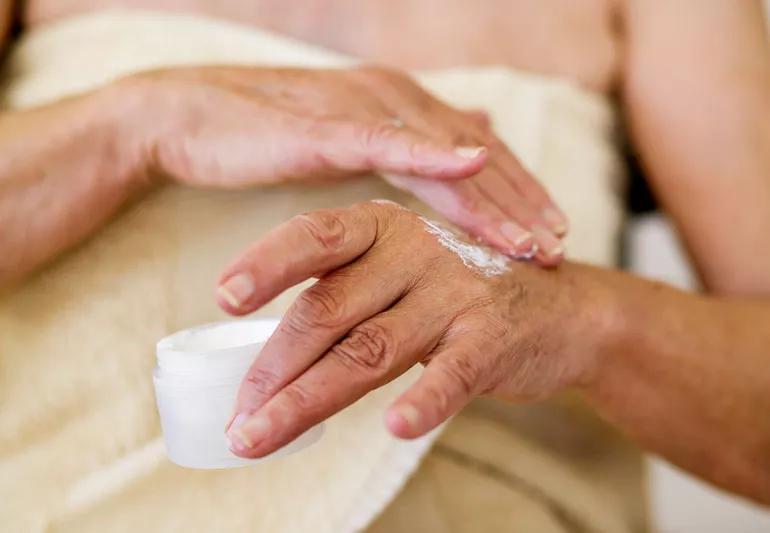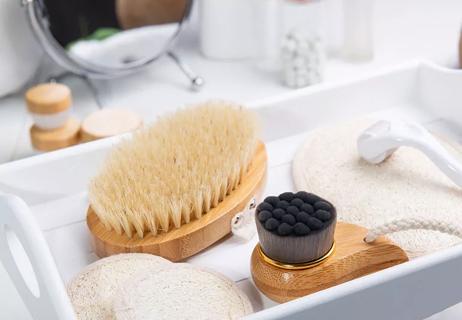Choose cream for your body and lotion for your face, and skip the fragrances and botanicals

For people living with dry skin, the pain is real. You want to stay healthy, so you frequently wash your hands (good job!) and use sanitizer when you’re in a pinch.
Advertisement
Cleveland Clinic is a non-profit academic medical center. Advertising on our site helps support our mission. We do not endorse non-Cleveland Clinic products or services. Policy
But, particularly in cold weather, even basic hygiene can leave your skin feeling tight, itchy and uncomfortably dry.
The key? Choosing the right moisturizer for your dry skin and following some dermatologist-backed advice for keeping your skin clean and hydrated.
But with so many skin care products available — all promising your “best skin ever” — which moisturizer is right for your dry skin? Dermatologist Alejandra Estemalik, MD, does a deep dive into moisturizers: What to look for, how to apply it and other ways to care for your dry skin.
Your moisturizer’s top job is to hydrate your skin’s moisture barrier.
What’s that?
“Your skin barrier is the outermost layer of your skin,” Dr. Estemalik explains. “It provides a kind of armor that protects the cells beneath from damage.”
Cold weather, harsh soaps, over-exfoliating and more can all damage that tough outer shell, leaving your skin dry, flaky or itchy.
Using the right moisturizer can keep your skin healthy by hydrating that all-important layer of armor. Moisturizers for dry skin from brands like CeraVe®, Aveeno®, Avène®, La Roche-Posay®, Eucerin® and Cetaphil® are among those that Dr. Estemalik recommends most.
What makes some moisturizers for dry skin better than others? Let's look at how to choose an effective moisturizer for your dry skin.
Advertisement
Dry skin on your body will benefit from a moisturizing cream. Not lotion. There’s a difference.
“Anything that hydrates your skin is considered a moisturizer,” Dr. Estemalik explains. “But products that are labeled as ‘lotions’ contain more water and more alcohol than creams. So, lotions are more likely to dry your skin.”
For your face, lotion is a good choice. More on that in a bit.
You’re better off with fragrance-free and botanical-free products, particularly if you have dry, sensitive skin or any allergies.
“Fragrances and botanicals are common allergens and should be avoided, especially if your skin is sensitive,” Dr. Estemalik points out. “When you apply a fragrance product on your skin, it eventually causes inflammation because it’s a skin allergen. And inflammation leads to flakiness and itchiness.”
Plant-derived, “all-natural” and “organic” botanicals are thought to be better for your skin because they’re found in nature. But as Dr. Estemalik notes, so is poison ivy. “Fragrance is like sugar. We all crave it, but it’s bad for our skin.”
Dr. Estemalik says to avoid fragrances and botanicals in your skin care products, including:
And even if a product is labeled as fragrance-free, that doesn’t mean it’s allergen-free.
“People think that fragrance-free means hypoallergenic. But if the moisturizer contains any of these botanical products, it’s definitely not hypoallergenic,” Dr. Estemalik adds.
When choosing a moisturizer, look first at the ingredients panel — not the price tag.
“Skin care products range in price dramatically. But a high price doesn’t mean a product is going to work any better than a less expensive version,” Dr. Estemalik emphasizes. “The mix of ingredients will tell you much more about the potential of your skin care products to be effective than relying on price.”
There are a few classes of ingredients you want to look for in a good moisturizer to treat dry, flaky or scaly skin. They are:
“A good moisturizer will contain ingredients from all three of these classes to hydrate and protect dry skin,” Dr. Estemalik says.
Let’s take a closer look at these dry skin ingredients.
Humectants are ingredients that hydrate your skin by drawing water up from your second layer of skin (dermis) to the topmost layer (epidermis). They also help you shed dead skin cells and use the water in humid air to moisturize the epidermis.
Advertisement
Popular and effective humectants in moisturizers for dry skin include:
Occlusives work in tandem with humectants. They kick things up a notch, preventing moisture loss so your skin stays hydrated longer.
Look for ingredients like:
Emollients act like asphalt patches on a road of potholes: They fill in the cracks that dryness causes, which smooths and softens your skin. Emollients can also be occlusives, so get a twofer by choosing a moisturizer with:
About half your epidermis is made up of natural ceramides. They’re lipids that help lock in moisture.
Synthetic ceramides in your moisturizer can help give your natural ceramides a hydrating boost.
Look for these common ceramides in your moisturizer:
When choosing a facial moisturizer for your dry skin, make sure to look for products that are noncomedogenic, which means non-acne-causing.
“Your face has thinner skin than your body, which makes it more sensitive,” Dr. Estemalik explains. “A good facial moisturizer should be a bit lighter. A gel or lotion is generally better for the face unless you have very dry skin.”
Advertisement
And use a moisturizer with SPF 30 or higher year-round. SPF helps protect you from the sun’s damaging UVA and UVB rays, which is important for preventing skin cancer and for limiting the sun’s aging effects.
“I like face moisturizers that have a mineral SPF in it, such as zinc oxide or titanium dioxide,” Dr. Estemalik suggests.
Antiaging skin care ingredients like vitamin C and retinol are also good additions to your facial moisturizer.
OK, you’ve got the right moisturizer. But how you use it is just as important as the product itself.
Surprisingly, there’s more to it than “just slather it on.”
Dr. Estemalik recommends these steps to help hydrate your dry skin.
It might seem radical, but it’s best to nix your daily shower if you have dry skin. Try to lather up every other day instead.
“Your skin barrier can eventually develop little micro irritations when you shower too often,” Dr. Estemalik says. “That damage accumulates over days and months. This leads to dry, cracked skin that’s more likely to develop rashes and skin infections.”
Damaged skin becomes more vulnerable to potential allergens, irritants and pathogens, including viruses and bacteria like staphylococcus.
“That’s also why over-washing makes kids with eczema more prone to warts and viral skin infections,” he adds.
Advertisement
Sorry for those who like to steam it up, but keep your shower water lukewarm, not hot.
Water strips your skin of its protective barrier — the natural oils that keep irritants out and hydration in. And scalding hot showers worsen the situation by evaporating even more moisture from your skin.
Rather than lingering around in the bath or shower, your skin will appreciate keeping your showers quick but effective. When you can, keep the shower short — just five to 10 minutes max — and focus on the “dirty areas” such as your armpits, groin and feet.
When you get out of the shower, keep the toweling off to a minimum.
“As soon as you come out, pat dry to the point you’re not dripping, but keep a little water on your skin,” Dr. Estemalik recommends. “Then, apply your moisturizer within three minutes to help trap the moisture there.”
What good is that moisturizer if you don’t use it consistently? Use it after every bath or shower for best results.
“After showering, your moisturizer can help restore the oils you lose when you wash and protect your skin,” Dr. Estemalik emphasizes. “Consistency is key. Especially if you have atopic dermatitis or eczema, the consistent use of moisturizer will reduce symptoms, symptom frequency and disease flares.”
If the right moisturizer and shower routine don’t help your dry skin, get in touch with a healthcare provider like a dermatologist. They can help you feel better in your skin.
Learn more about our editorial process.
Advertisement

Deal with dry skin by preserving your skin’s moisture, using moisturizing products and taking preventive action

Get tips for doing it correctly from a dermatologist

Early attention to skin wounds can help minimize their appearance later

Several conditions, like vitiligo and fungal infection, can cause a loss of pigmentation, leading to white spots or patches on your skin

Moisturizing, running a humidifier and adjusting your showers may help keep itchiness and irritation at bay

‘Zit stickers’ can help heal a new or popped pimple, but they’re limited when it comes to managing acne

Glycolic acid benefits skin tone, texture and pigmentation by exfoliating dead skin

At-home treatments and lifestyle changes may help ease the symptoms and improve the appearance of varicose veins — but they aren’t a cure

The best parenting style balances enforcing rules and showing plenty of love

Tips include cutting back on sugar, focusing on exercise and managing stress

It can be harder to let go when you’ve invested time, energy and emotions — but it might be the healthier choice long term